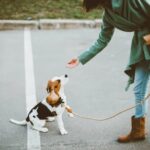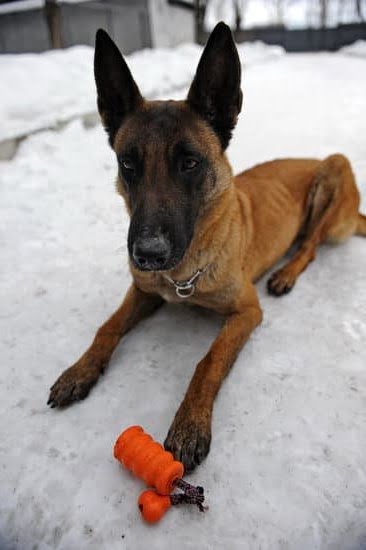In a world where loud noises and sudden sounds are part of everyday life, training your dog not to be gun shy is crucial for their overall well-being. Gun shyness, also known as noise phobia, can have a significant impact on a dog’s behavior, causing them to exhibit fear, anxiety, and even aggression in response to loud sounds like gunshots.
However, with the right techniques and commitment to desensitization and counterconditioning, you can help your furry friend overcome this fear and live a happier, fear-free life.
Gun shyness in dogs refers to an extreme fear or aversion to loud noises associated with firearms. This phobia not only affects their behavior but can also lead to physical distress such as trembling, excessive barking or whining, hiding or seeking shelter when exposed to the sound of guns. It is essential to understand the significance of desensitizing and counterconditioning techniques in helping dogs overcome this fear.
The root causes of gun shyness can vary from genetic factors and breed predispositions to traumatic experiences and negative associations. Identifying potential triggers that contribute to gun shyness is crucial in developing effective training strategies.
Early socialization plays a vital role in preventing gun shyness in puppies by exposing them gradually and positively to various sounds, including firearm noises. By building positive associations through rewards and praise during early socialization periods, you can greatly reduce the likelihood of gun shyness later in life.
Understanding how dogs communicate their feelings through body language is essential when training them not to be gun shy. Recognizing signs of stress and anxiety allows us to tailor our training methods accordingly while ensuring the process remains positive for our canine companions. By staying attuned to their behavioral cues during training sessions, we can make adjustments and create a safe environment that promotes relaxation.
In the following sections, we will explore various training techniques that can be employed to help your dog overcome gun shyness. From gradual desensitization to creating a safe training environment that promotes relaxation, we will delve into positive reinforcement methods that build confidence and trust in your dog.
Additionally, we will discuss the benefits of seeking professional help and how real-life success stories can inspire and encourage you on your training journey. By investing time, effort, and patience in training, you have the power to empower your dog and ensure they live a happy, fear-free life.
The Root Causes of Gun Shyness in Dogs
Gun shyness in dogs can have various underlying causes that contribute to their fear and anxiety towards loud noises, particularly the sound of firearms. By understanding these root causes, dog owners can better address and prevent gun shyness in their pets.
Identifying potential triggers that contribute to gun shyness
One of the first steps in addressing gun shyness in dogs is identifying potential triggers that contribute to their fear. Loud noises, such as fireworks or thunderstorms, are common triggers for gun shy behavior. Other triggers might include sudden movements or unfamiliar environments. By understanding what specifically triggers your dog’s fear response, you can tailor your training techniques accordingly and work on desensitizing them.
Genetic factors and breed predispositions
It is important to note that some dogs may be more prone to developing gun shyness due to genetic factors or breed predispositions. Certain breeds have a higher likelihood of being sensitive to loud noises and exhibiting fear-related behaviors. Understanding your dog’s breed characteristics and tendencies can help you anticipate potential challenges in training for gun shyness.
Traumatic experiences and negative associations
Traumatic experiences or negative associations with loud noises can also contribute to a dog becoming gun shy. For example, if a puppy was exposed to a loud noise unexpectedly without proper preparation or positive reinforcement, it may form a lasting negative association with similar sounds in the future.
Dogs who have had traumatic experiences related to firearms may develop an aversion towards those specific sounds. Identifying any past traumatic incidents can help inform your training approach and ensure it is tailored to address those specific fears.
By understanding the root causes of gun shyness in dogs, pet owners can take proactive steps towards prevention and intervention. Whether it’s identifying triggers, considering genetic factors, or addressing traumatic experiences, this knowledge lays the foundation for effective training techniques that will help your dog overcome their fear of firearms.
Starting Young
Early socialization plays a crucial role in preventing gun shyness in dogs. The critical period for socialization occurs between 3 to 14 weeks of age, during which puppies are most receptive to new experiences and learning. By exposing puppies to various sounds, including firearm noises, gradually and positively, they can develop a sense of familiarity and comfort with these sounds.
One effective method is to start with low-intensity noises such as recordings of distant gunshots or the sound of gunfire played at a very low volume. Allow the puppy to explore their environment freely while these sounds are playing in the background.
It is important to observe the puppy’s behavior and body language throughout the process. If they show signs of fear or anxiety, such as cowering, trembling, or excessive panting, it may be necessary to decrease the volume or pause the exposure and provide reassurance.
Positive reinforcement is crucial during this stage. Whenever the puppy remains calm or shows curiosity towards the noise, reward them with treats or verbal praise. This helps create positive associations with the sound of gunfire and builds confidence.
It’s important to note that each puppy will have its own unique tolerance level for loud noises. Some may naturally be more sensitive than others, so it’s essential to tailor the training approach based on individual needs and comfort levels. Gradually increase the volume and exposure over time as the puppy becomes more comfortable.
By starting early with socialization efforts that include exposure to gun-related sounds in a positive manner, dog owners can significantly reduce the risk of their dogs developing gun shyness later in life. This foundation sets the stage for a confident and well-adjusted dog who can handle various situations calmly and without fear.
Understanding Dog Communication and Behavior
Understanding dog communication and behavior is crucial when training a dog not to be gun shy. Dogs have their own unique ways of expressing fear and discomfort, and as responsible pet owners, it is essential to recognize these signs. Being attuned to your dog’s behavioral cues during training will help you tailor the training approach to suit their individual needs.
One important aspect of dog communication is recognizing signs of stress and anxiety. Some common signs include panting, pacing, trembling, hiding, excessive barking or whining, excessive drooling, and avoidance behaviors. Dogs may also display body language such as tail tucking, ears pinned back, cowering or freezing in place when they are fearful or uncomfortable.
It is equally important to learn how dogs express fear so that you can address it appropriately during training. Dogs may exhibit fear through submissive postures such as lowered body posture with the head down, avoiding eye contact, and lip licking. On the other hand, some dogs may display defensive behaviors like growling or showing teeth when they feel threatened or scared.
During training sessions, always provide a safe and supportive environment for your dog. Creating a positive association with the training process will help alleviate their anxiety and build trust. Pay attention to their body language throughout the training session, making adjustments as needed to ensure their comfort. Remember that every dog is unique and may require different approaches based on their temperament and past experiences.
By understanding dog communication and behavior, you will be better equipped to train your dog not to be gun shy effectively. Recognizing signs of stress and anxiety allows you to adjust your training methods accordingly while creating a safe environment enables them to relax during the process. By staying attuned to your dog’s behavioral cues during training sessions, you can tailor your approach to meet their individual needs for a successful outcome.
Training Techniques to Overcome Gun Shyness
Once you have identified that your dog is exhibiting signs of gun shyness, it is essential to implement effective training techniques to help them overcome their fear and anxiety. The following section will outline some proven methods that can be used to gradually desensitize your dog to gun-related sounds and build their confidence.
One effective technique for training a dog not to be gun shy is gradual desensitization. This involves exposing your dog to the sound of firearms in a controlled and positive manner.
Start by playing recorded gun noises at a very low volume while engaging your dog in activities they enjoy, such as playing or receiving treats. As your dog becomes more comfortable with the sound at a low volume, gradually increase the volume over time until they no longer show signs of fear or anxiety.
To create a safe training environment that promotes relaxation and comfort, it is important to ensure that your dog associates positive experiences with the previously feared sound. For example, you can pair the sound of gunfire with something pleasurable for your dog, such as their favorite treat or toy. This will help them form positive associations and replace their fear response with feelings of enjoyment and reward.
Positive reinforcement techniques are crucial when training a dog not to be gun shy. Reward-based training using treats, toys, and verbal praise can help build confidence and trust in your dog. Whenever they exhibit calm behavior during exposure to firearms sounds or show signs of overcoming their fear, reward them immediately with positive reinforcement. This will reinforce their desired behavior and strengthen their confidence over time.
It is important to note that consistency, repetition, and patience are key throughout the training process. Overcoming gun shyness may take time depending on the severity of your dog’s fear and anxiety levels. Implementing these techniques consistently on a regular basis will gradually yield results. Remember that each dog is unique, so tailoring the training approach based on your dog’s reactions and progress is crucial for success.
By using these training techniques, you can help your dog overcome their gun shyness and live a happy, fear-free life. Remember to be patient with your furry friend during the process, as building their confidence takes time. The next section will explore positive reinforcement methods that can be used in conjunction with these training techniques to further support your dog’s progress in overcoming gun shyness.
Positive Reinforcement Methods for Gun Shyness Training
Positive reinforcement is a highly effective method for training dogs not to be gun shy. By using rewards, praise, and other positive stimuli, you can build confidence and trust in your dog, helping them overcome their fear of loud noises associated with firearms. This section will explore various positive reinforcement techniques that can be implemented during gun shyness training.
Reward-based training
Reward-based training involves reinforcing desired behaviors with treats, toys, or verbal praise. When it comes to gun shyness training, this approach can help create positive associations with firearm sounds. For example, whenever your dog hears a gunshot or a similar sound, you can immediately reward them with a high-value treat or toy. Over time, your dog will learn to associate the noise with something pleasant instead of feeling fear or anxiety.
In addition to rewards, it is crucial to provide ample praise during training sessions. Verbal encouragement such as “good job” or “well done” can reinforce the positive behavior and boost your dog’s confidence. Remember to be consistent and timely with your rewards and praise to ensure that your dog connects them directly with the desired behavior.
Clicker training
Clicker training is another effective tool for association and behavior modification during gun shyness training. With clicker training, you use a small device that makes a clicking sound when pressed. The click serves as an immediate marker for correct behavior, indicating to the dog that they have done something right.
To use clicker training for gun shyness prevention or rehabilitation, start by pairing the sound of the clicker with treats or rewards during sessions unrelated to firearms. Once your dog understands that the click precedes positive outcomes like food or playtime, you can gradually introduce firearm sounds while clicking and rewarding immediately afterward.
The clicker becomes an important signal that helps your dog form positive associations with the gunfire noises over time. It is essential to practice patience and consistency when implementing clicker training as it may take several sessions for your dog to fully understand the desired response.
Consistency, repetition, and patience
Consistency, repetition, and patience are key elements in positive reinforcement training for gun shyness. Dogs learn through consistent repetition, so it is crucial to provide regular opportunities for exposure to firearm sounds in a controlled and safe environment.
Create a training schedule that includes short but frequent sessions where you gradually increase the volume and intensity of the noises. As your dog becomes more comfortable with each level of sound, reward their progress consistently. It is essential not to rush the process or overwhelm your dog too quickly, as this can trigger anxiety or fear.
Remember that each dog is unique, and progress may vary from one individual to another. Some dogs may require more time and effort before showing significant improvement. By staying patient and maintaining a positive attitude throughout the training journey, you will help your dog build confidence and ultimately overcome their gun shyness.
Seeking Professional Help
Training a dog not to be gun shy can be a complex and challenging process. If you are facing difficulties or feel overwhelmed, it may be beneficial to seek the help of a professional dog trainer or behaviorist.
One of the primary benefits of hiring a dog trainer is their expertise in understanding canine behavior and effective training techniques. A professional trainer can assess your dog’s specific needs and create a tailored training plan to address gun shyness. They have the knowledge and experience to identify any underlying issues that may contribute to your dog’s fear response, such as anxiety or trauma.
Moreover, involving a professional can provide you with guidance and support throughout the training journey. They can teach you how to effectively communicate with your dog, recognize behavioral cues, and adjust your training methods accordingly. Additionally, they can work with you on building a strong foundation of trust between you and your furry companion.
Hiring a dog trainer also offers an objective perspective on your dog’s progress. Sometimes it can be challenging for pet owners to accurately assess their own training effectiveness. A trainer can provide valuable feedback and make necessary adjustments to ensure the best possible outcome for both you and your dog.
Real-Life Stories
One of the most powerful ways to inspire and motivate dog owners who are working to train their dogs not to be gun shy is through real-life stories of success. These stories showcase the remarkable transformations that can occur when dogs are given the opportunity to overcome their fear of firearms. By sharing these stories, we can provide hope and encouragement to those who may be facing similar challenges with their own dogs.
Inspirational anecdotes of dogs who conquered their gun shyness serve as a testament to the effectiveness of training techniques and highlight the resilience and adaptability of our canine companions. For example, there are countless stories of sensitive rescue dogs who were initially fearful of loud noises, including gun-related sounds, but with patience, consistency, and positive reinforcement training, they were able to overcome their fears and develop a newfound confidence.
Testimonials from dog owners who successfully trained their dogs not to be gun shy offer valuable insights into the training process. These firsthand accounts often include details about specific techniques used, challenges encountered along the way, and the rewards reaped from their efforts. Sharing these testimonials can foster a sense of community amongst dog owners facing similar struggles while offering practical advice and encouragement.
Additionally, encouraging readers to share their own experiences and support each other in the training journey allows for an exchange of ideas and strategies. This collaborative approach empowers dog owners by providing them with a platform to seek advice, find solace in shared experiences, celebrate successes together, and ask questions about any obstacles they may encounter during their training journey.
By highlighting real-life success stories throughout this article, we aim to uplift readers’ spirits while reinforcing the belief that overcoming gun shyness is indeed possible with dedication and appropriate training methods. These narratives provide both inspiration and practical guidance as dog owners work towards ensuring a happy, fear-free life for their beloved companions.
| Inspirational Anecdotes | Testimonials from Dog Owners |
|---|---|
| Rescue dogs overcoming gun shyness through training | Firsthand accounts of successful training techniques |
| Demonstrates resilience and adaptability of dogs | Shares challenges, rewards, and insights from the training process |
| Fosters a sense of community among dog owners | Encourages sharing of experiences and collaborative learning |
Conclusion
In conclusion, training your dog not to be gun shy is a crucial aspect of their overall well-being and behavior. By understanding the root causes of gun shyness in dogs and utilizing effective training techniques, you can empower your dog to live a happy and fear-free life.
Starting young with early socialization plays a significant role in preventing gun shyness. Introducing puppies to various sounds, including firearm noises, in a gradual and positive manner builds positive associations and helps them develop confidence. It is essential to recognize signs of stress and anxiety in your dog, as well as staying attuned to their behavioral cues during training. This awareness allows you to adjust the training approach and create a safe environment that promotes relaxation.
Positive reinforcement methods are highly effective in overcoming gun shyness. Reward-based training using treats, toys, verbal praise, and clicker training can modify behavior and build confidence. Consistency, repetition, patience are key in the training process.
However, if you find yourself struggling or the problem becomes too challenging to handle on your own, seeking professional help from a dog trainer or behaviorist is beneficial. They can provide expert guidance tailored to your specific case and work collaboratively with you to address individual needs.
Lastly, it is important to celebrate success stories of dogs who have overcome gun shyness and share these stories with others for inspiration. By creating a supportive community where readers can share their own experiences, we can offer encouragement and support throughout the training journey.
Remember that by investing time and effort into training your dog not to be gun shy, you are ensuring their quality of life by empowering them with confidence and creating a fear-free environment. With patience, consistency, positive reinforcement techniques, and potentially assistance from professionals when needed, you can achieve success in building a strong bond with your furry companion.
Frequently Asked Questions
How do I get my dog to stop being gun shy?
To help your dog stop being gun shy, it’s important to approach the issue with patience and understanding. Start by gradually exposing your dog to the sound of gunshots in a controlled and positive environment. Begin by playing recordings of gunshots at a very low volume while engaging your dog in enjoyable activities or feeding him treats.
Slowly increase the volume over time, always monitoring your dog’s response and ensuring he remains calm. It may also be beneficial to consult with a professional dog trainer who specializes in desensitizing dogs to loud noises like gunfire.
Can a gun shy dog be cured?
While there is no guarantee that all gun shy dogs can be completely cured, many can significantly improve their reaction to loud noises through proper training and desensitization techniques. The key lies in providing positive associations with the sounds of gunfire to help diminish fear or anxiety responses over time.
However, it’s crucial to remember that each dog is unique, so some dogs may require more extensive training or management throughout their lives.
How do I build my gun dog confidence?
Building confidence in a gun dog involves consistent training, socialization, and exposure to various environments and situations. Start with basic obedience training using positive reinforcement techniques such as treats or praise for desired behaviors. Gradually introduce your gun dog to new experiences, sights, smells, and sounds while providing reassurance and rewards for calm behavior.
This could include exposing them to different terrains, bodies of water, other animals, and controlled hunting scenarios if applicable. Consistency is key – regular training sessions combined with positive reinforcement will help build your gun dog’s confidence over time. Remember that building confidence is an ongoing process that requires patience and dedication from the owner or handler.

Welcome to the blog! I am a professional dog trainer and have been working with dogs for many years. In this blog, I will be discussing various topics related to dog training, including tips, tricks, and advice. I hope you find this information helpful and informative. Thanks for reading!





